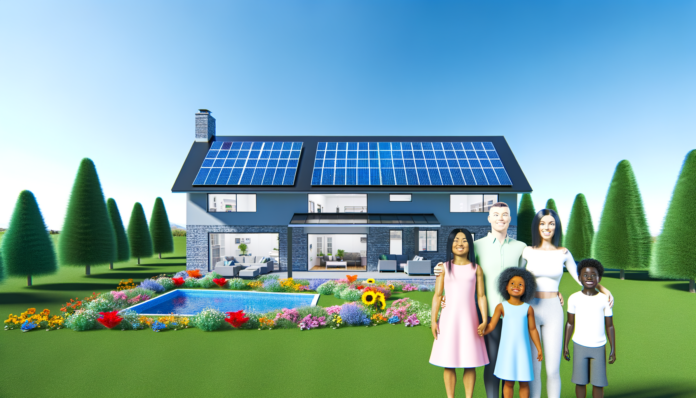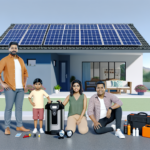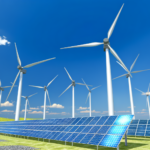Introduction to Home Solar Power
The Growing Importance of Solar Energy
The significance of solar energy has been steadily increasing over the past few decades. As the world grapples with the adverse effects of climate change and the depletion of fossil fuels, solar energy emerges as a sustainable and renewable alternative. According to the National Renewable Energy Laboratory (NREL), solar energy could provide up to 45% of the electricity in the United States by 2050 if the energy system is fully decarbonized. This projection underscores the critical role solar energy will play in the future energy landscape, not just in the U.S. but globally.
Solar energy’s growth is driven by several factors, including technological advancements, declining costs, and increased awareness of environmental issues. Innovations in photovoltaic (PV) technology and concentrating solar power (CSP) have made solar energy more efficient and affordable. Additionally, the integration of solar energy with other renewable sources like wind and storage solutions enhances its viability as a primary energy source.
Benefits of Solar Power for Homeowners
For homeowners, the adoption of solar power offers a multitude of benefits, both financial and environmental. Here are some key advantages:
- Cost Savings: One of the most compelling reasons to switch to solar power is the potential for significant cost savings. By generating your own electricity, you can reduce or even eliminate your monthly utility bills. Additionally, various financial incentives, such as the Solar Investment Tax Credit (ITC), can further lower the initial investment cost.
- Energy Independence: Solar power provides homeowners with greater energy independence. By producing your own electricity, you become less reliant on the grid and less vulnerable to energy price fluctuations.
- Environmental Impact: Solar energy is a clean and renewable source of power. By switching to solar, homeowners can significantly reduce their carbon footprint and contribute to the fight against climate change.
- Increased Property Value: Homes equipped with solar power systems often have higher property values. Prospective buyers are increasingly looking for energy-efficient homes, making solar installations a valuable asset.
- Low Maintenance: Solar power systems require minimal maintenance. Once installed, they can operate efficiently for decades with little intervention, providing a hassle-free energy solution.
Overview of Solar Power Technology
Understanding the basic technology behind solar power is essential for anyone considering making the switch. A typical home solar power system consists of several key components:
- Solar Panels: These are the most visible part of the system and are responsible for capturing sunlight and converting it into direct current (DC) electricity. Solar panels are made up of photovoltaic cells, usually composed of silicon, which generate electricity when exposed to sunlight.
- Inverters: The electricity generated by solar panels is in DC form, but most home appliances run on alternating current (AC). Inverters convert the DC electricity into AC, making it usable for household needs.
- Mounting Systems: These are used to secure the solar panels to your roof or the ground. The type of mounting system can vary depending on the installation site and the specific requirements of the solar panels.
- Battery Storage: To ensure a continuous power supply, even when the sun isn’t shining, many solar power systems include battery storage. These batteries store excess electricity generated during the day for use at night or during cloudy periods.
- Monitoring Systems: These systems track the performance of your solar power setup, providing real-time data on energy production and consumption. Monitoring systems help in optimizing the efficiency and maintenance of the solar power system.
In summary, the growing importance of solar energy, coupled with its numerous benefits for homeowners and the advancements in solar technology, makes it a compelling choice for a sustainable and cost-effective energy solution. As we move towards a more sustainable future, home solar power systems will play a crucial role in reducing our reliance on fossil fuels and mitigating the impacts of climate change.
Key Components of a Home Solar Power System
Solar Panels: Types and Efficiency
Solar panels are the most recognizable component of a home solar power system. They are responsible for capturing sunlight and converting it into electricity. The two main types of solar panels are **monocrystalline** and **polycrystalline**. Monocrystalline panels are made from a single crystal structure, making them more efficient and longer-lasting, typically offering efficiencies between 15-20%. Polycrystalline panels, on the other hand, are made from multiple silicon crystals and are generally less expensive but slightly less efficient, with efficiencies ranging from 13-16%.
Efficiency is a critical factor when choosing solar panels. It is defined as the amount of power produced per square meter of sunlight. Higher efficiency panels can generate more electricity in a given space, making them ideal for homes with limited roof space. The average efficiency of solar panels falls between 17-19%, but advancements in technology are continually pushing these numbers higher.
Inverters: Converting DC to AC
The electricity generated by solar panels is in the form of direct current (DC), but most home appliances run on alternating current (AC). This is where inverters come into play. Inverters convert the DC electricity from the panels into AC electricity that can be used in your home. There are two main types of inverters: **string inverters** and **microinverters**.
String inverters are typically mounted on a wall and convert the DC electricity from a string of solar panels into AC. Microinverters, on the other hand, are installed on the back of each solar panel, converting DC to AC at the panel level. Microinverters can offer better performance in systems where shading or panel orientation varies, as they optimize the output of each individual panel.
Mounting Systems: Roof and Ground Options
Mounting systems are essential for securing solar panels to your roof or the ground. **Roof-mounted systems** are the most common and are ideal for homes with sufficient roof space and good sun exposure. These systems use rails, brackets, and other hardware to attach the panels securely to the roof.
**Ground-mounted systems** are an alternative for homes with limited roof space or where the roof is not suitable for solar panels. These systems are installed on the ground and can be adjusted for optimal sun exposure. Ground-mounted systems often require more space and can be more expensive due to additional materials and labor.
Battery Storage: Ensuring Energy Availability
Battery storage systems are becoming increasingly popular as they allow homeowners to store excess solar energy for use when the sun is not shining, such as during the night or on cloudy days. **Lithium-ion batteries** are the most common type used in home solar systems due to their high energy density, long lifespan, and relatively low maintenance.
Battery storage systems can provide energy independence and security, ensuring that you have power even during grid outages. They also allow you to maximize the use of your solar energy, reducing reliance on the grid and potentially lowering your energy bills.
Monitoring Systems: Tracking Performance
Monitoring systems are crucial for tracking the performance of your solar power system. These systems provide real-time data on energy production, consumption, and system health. Monitoring can be done through dedicated hardware or software platforms that are often integrated with the inverter.
A comprehensive monitoring system can help you identify issues early, optimize system performance, and ensure that you are getting the most out of your solar investment. Some advanced monitoring systems also offer features like fault detection, energy yield data, and performance analytics, helping you make informed decisions about your energy use and system maintenance.
In summary, understanding the key components of a home solar power system—solar panels, inverters, mounting systems, battery storage, and monitoring systems—can help you make informed decisions and optimize the performance and efficiency of your solar investment.
Planning and Designing Your Solar Power System
Assessing Your Energy Needs
Before diving into the technical aspects of a home solar power system, it’s crucial to understand your household’s energy consumption. Start by reviewing your electricity bills over the past year to determine your average monthly and annual energy usage, measured in kilowatt-hours (kWh). This data will help you estimate the size of the solar power system you need. Consider future changes in energy consumption, such as the addition of electric vehicles or new appliances, to ensure your system can accommodate increased demand.
Site Evaluation and Solar Potential
A thorough site evaluation is essential to determine the feasibility and efficiency of a solar power system. Key factors to consider include:
- Sunlight Exposure: Assess the amount of direct sunlight your property receives throughout the year. Tools like solar pathfinders and satellite imagery can help identify potential shading issues from trees, buildings, or other obstructions.
- Roof Condition: Ensure your roof is in good condition and can support the weight of solar panels. The roof’s orientation and tilt angle also affect solar panel efficiency; south-facing roofs with a tilt angle equal to your latitude are generally ideal.
- Space Availability: Determine the available space for solar panel installation. If roof space is limited, consider ground-mounted systems as an alternative.
System Sizing and Configuration
Once you’ve assessed your energy needs and site potential, the next step is to size and configure your solar power system. This involves:
- Calculating System Size: Use your average energy consumption to determine the total capacity of the solar system, typically measured in kilowatts (kW). A general rule of thumb is that 1 kW of solar panels produces about 1,200 to 1,500 kWh annually, depending on your location.
- Choosing Solar Panels: Select the type and number of solar panels based on their efficiency, cost, and available space. Monocrystalline panels are more efficient but costlier, while polycrystalline panels are less efficient but more affordable.
- Inverter Selection: Choose an inverter that matches your system size and configuration. Options include string inverters, microinverters, and power optimizers, each with its own advantages and drawbacks.
- Battery Storage: If you want to store excess energy for use during nighttime or power outages, consider adding a battery storage system. This can increase your energy independence and provide backup power.
Permits and Regulations
Navigating the permitting and regulatory landscape is a critical step in the planning process. Here are some key considerations:
- Local Permits: Obtain the necessary building and electrical permits from your local government. Requirements vary by location, so check with your local building department for specific guidelines.
- Utility Interconnection: Coordinate with your utility company to connect your solar system to the grid. This process often involves an application, inspection, and approval to ensure your system meets safety and technical standards.
- Incentives and Rebates: Research available incentives, rebates, and tax credits that can offset the cost of your solar power system. The federal Solar Investment Tax Credit (ITC) is a significant incentive, offering a 26% tax credit for systems installed by the end of 2022, and 22% for systems installed in 2023.
By carefully assessing your energy needs, evaluating your site, sizing and configuring your system, and navigating permits and regulations, you can design a solar power system that meets your household’s energy requirements and maximizes efficiency.
Installation Process
Choosing a Professional Installer
Selecting the right professional installer is crucial for a successful home solar power system. Look for installers with a solid track record, positive customer reviews, and relevant certifications such as NABCEP (North American Board of Certified Energy Practitioners). It’s advisable to get multiple quotes to compare pricing, services, and warranties. Ensure the installer is familiar with local building codes and regulations to avoid any compliance issues.
Installation Steps and Timeline
The installation process typically follows these steps:
1. **Initial Consultation and Site Assessment**: An expert will evaluate your energy needs, site conditions, and solar potential.
2. **Design and Permitting**: Engineers design a custom system, and the installer handles the necessary permits and approvals.
3. **Installation Day**:
– **Mounting the Panels**: Installers set up the mounting system on your roof or ground.
– **Electrical Wiring**: Panels are connected to the inverter and your home’s electrical system.
– **Inverter Installation**: The inverter converts DC to AC power.
– **System Testing**: The system is tested to ensure it operates correctly and safely.
4. **Final Inspection and Approval**: Local authorities inspect the system to ensure compliance with safety and building codes.
5. **System Activation**: Once approved, the system is activated, and you can start generating solar power.
The entire process can take anywhere from a few weeks to a few months, depending on permitting and inspection timelines.
Safety Considerations
Safety is paramount during the installation of a solar power system. Here are some key considerations:
– **Electrical Safety**: Ensure all electrical work is performed by licensed electricians to prevent hazards.
– **Structural Integrity**: Verify that your roof or ground mounting system can support the weight and wind loads of the solar panels.
– **Fire Safety**: Proper installation and maintenance reduce the risk of electrical fires. Ensure all components meet safety standards.
– **Personal Safety**: Installers should use appropriate safety gear and follow protocols to prevent falls and injuries.
Post-Installation Inspection
After the installation, a thorough inspection is conducted to ensure everything is up to code and functioning correctly. This includes:
– **Electrical Inspection**: Verifying that all electrical connections are secure and compliant with local codes.
– **Structural Inspection**: Ensuring the mounting system is properly installed and stable.
– **Performance Testing**: Checking that the system is generating the expected amount of power and that monitoring systems are operational.
Once the system passes inspection, it can be officially activated, and you can start enjoying the benefits of solar energy. Regular monitoring and maintenance will help keep your system running efficiently for years to come.
Maintenance and Troubleshooting
Routine Maintenance Tasks
Regular maintenance is crucial to ensure your home solar power system operates efficiently and has a long lifespan. Here are some essential routine maintenance tasks:
- Cleaning Solar Panels: Dust, dirt, bird droppings, and other debris can accumulate on the surface of solar panels, reducing their efficiency. Clean your panels at least twice a year using a soft brush or sponge and water. Avoid abrasive materials and harsh chemicals that can damage the panels.
- Inspecting for Shade: Regularly check for any new obstructions like growing trees or new buildings that might cast shadows on your panels. Trim any vegetation that could block sunlight.
- Monitoring System Performance: Use the monitoring app or software provided by your solar system manufacturer to track energy production. Compare the current output with historical data to identify any significant drops in performance.
- Checking Inverters: Inverters are critical components that convert DC electricity to AC. Regularly inspect them for error messages or unusual noises. Ensure they are well-ventilated and free from dust.
- Professional Inspections: Schedule professional inspections every two years or sooner if you notice performance issues. Professionals can identify and fix problems that might not be apparent to the untrained eye.
Common Issues and Solutions
Even with regular maintenance, you may encounter some common issues with your solar power system. Here are a few and their potential solutions:
- Excessive Shade: If you notice a sudden drop in energy output, check for new shading from trees, buildings, or other obstructions. Prune trees or consult a professional to adjust the panel placement.
- Dirt and Debris: Accumulated dirt can significantly reduce efficiency. Clean the panels and recheck the output. If the problem persists, consider professional cleaning services.
- Physical Damage: Inspect panels for cracks or other damage. Even small cracks can reduce efficiency. Take pictures and consult a professional for repairs or replacements.
- Inverter Issues: If the inverter shows error messages or shuts down, check for overloading and ensure proper ventilation. If problems persist, consult a professional.
- Battery Not Holding Charge: For systems with battery storage, check for sulfation in lead-acid batteries or verify charge controller settings. If the battery is old, consider replacing it.
- Wiring Problems: Inspect all electrical connections for wear, fraying, or corrosion. Ensure all connections are tight and secure. If you find any issues, consult a professional.
When to Call a Professional
While many maintenance tasks can be handled by homeowners, some situations require professional expertise:
- Lack of Experience: If you are not comfortable or experienced with electrical systems, it’s best to hire a professional for maintenance and repairs.
- Significant Performance Drops: If you notice a consistent and significant decrease in energy output, it could indicate a more serious issue. A professional can diagnose and fix the problem.
- Physical Damage: For any physical damage to the panels or other components, consult a professional to avoid further damage and ensure safety.
- Inverter and Battery Issues: Inverters and batteries are complex components. If you encounter problems with these, it’s best to have a professional inspect and repair them.
- Warranty Considerations: DIY repairs can sometimes void warranties. Always check your warranty terms and consider professional services to maintain warranty coverage.
By following these maintenance and troubleshooting guidelines, you can ensure your home solar power system remains efficient and reliable, providing you with clean energy for years to come.
Maximizing Efficiency and Performance
Optimizing Panel Placement
Proper placement of solar panels is crucial for maximizing their efficiency. Panels should be positioned to capture the most sunlight throughout the day, avoiding shadows from trees, buildings, or other obstructions. The angle and orientation of the panels also play a significant role. Ideally, panels should face south in the Northern Hemisphere and north in the Southern Hemisphere to receive the maximum amount of sunlight. The tilt angle should be adjusted according to the latitude of the location to optimize exposure.
Seasonal Adjustments
Seasonal changes can affect the performance of solar panels. During winter, the sun is lower in the sky, and panels may need to be adjusted to a steeper angle to capture more sunlight. Conversely, in summer, a flatter angle may be more effective. Some mounting systems allow for manual or automatic adjustments to the tilt angle, ensuring that panels are always positioned for optimal sunlight capture throughout the year.
Energy Management Tips
Effective energy management can significantly enhance the performance of a home solar power system. Here are some tips:
- Monitor Usage: Regularly monitor your energy consumption to identify patterns and adjust usage accordingly.
- Use Energy-Efficient Appliances: Invest in energy-efficient appliances to reduce overall energy consumption.
- Time Your Usage: Use high-energy appliances during peak sunlight hours to maximize the use of solar power.
- Implement Smart Home Systems: Integrate smart home systems to automate and optimize energy usage based on real-time data.
Upgrading Components
Upgrading components of your solar power system can lead to significant improvements in efficiency and performance. Consider the following upgrades:
- High-Efficiency Panels: Replace older panels with newer, high-efficiency models to increase energy production.
- Advanced Inverters: Upgrade to advanced inverters that offer better conversion efficiency and monitoring capabilities.
- Battery Storage: Add or upgrade battery storage systems to store excess energy for use during non-sunny periods.
- Monitoring Systems: Implement advanced monitoring systems to track performance and identify issues early.
By optimizing panel placement, making seasonal adjustments, managing energy usage effectively, and upgrading components, homeowners can maximize the efficiency and performance of their home solar power systems, ensuring they get the most out of their investment.
Future Trends in Home Solar Power
Advancements in Solar Technology
The solar energy industry is experiencing rapid technological advancements that are set to revolutionize home solar power systems. One of the most significant developments is the increase in solar panel efficiency. Modern solar panels now achieve conversion efficiencies exceeding 20%, with some even surpassing 25%. This means that homeowners can generate more electricity from the same amount of sunlight, making solar power more viable and cost-effective.
Another groundbreaking innovation is the development of perovskite solar cells. These cells offer a cheaper and more efficient alternative to traditional silicon cells. Perovskite solar cells are easier to manufacture and can be produced at a lower cost, which could significantly reduce the price of solar panels in the future. Additionally, bifacial solar panels, which capture sunlight from both sides, are becoming more popular. This technology can increase energy production by up to 30%, making solar installations more productive and economical.
Integration with Smart Home Systems
The integration of solar power systems with smart home technologies is another exciting trend. Smart solar panels equipped with sensors and Internet of Things (IoT) capabilities allow for superior monitoring and optimization of solar energy production. These smart systems can adjust the orientation of solar panels to maximize sunlight capture, track energy production in real-time, and even predict maintenance needs.
Moreover, the use of artificial intelligence (AI) in solar energy management is on the rise. AI algorithms can analyze energy consumption patterns and weather forecasts to optimize energy storage and usage. This ensures that homeowners get the most out of their solar power systems, reducing reliance on the grid and lowering electricity bills. The integration of solar power with smart home systems not only enhances efficiency but also provides a seamless and user-friendly experience for homeowners.
The Role of Solar in a Sustainable Future
Solar power is poised to play a crucial role in creating a sustainable future. As the world grapples with climate change and the need to reduce carbon emissions, solar energy offers a clean and renewable alternative to fossil fuels. The widespread adoption of solar power can significantly reduce greenhouse gas emissions, helping to mitigate the effects of climate change.
In addition to environmental benefits, solar power also offers economic advantages. The cost of solar panels has been steadily decreasing, making solar energy more accessible to a broader audience. Governments around the world are also providing incentives and subsidies to encourage the adoption of solar power, further driving its growth.
Furthermore, advancements in energy storage technologies, such as lithium-ion and flow batteries, are making it easier to store and use solar energy even when the sun isn’t shining. This ensures a reliable and consistent energy supply, making solar power a more attractive option for homeowners and businesses alike.
In conclusion, the future of home solar power is bright, with continuous advancements in technology, integration with smart home systems, and its pivotal role in achieving a sustainable future. As these trends continue to evolve, solar power will become an increasingly integral part of our energy landscape, offering a cleaner, more efficient, and cost-effective solution for powering our homes.






